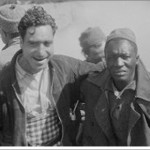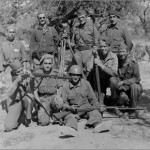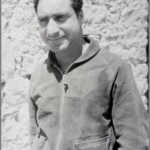Far from Baghdad, Two Iraqi Volunteers in the XVth International Brigade
Information about the Iraqi volunteers was brought to light in the memoir of Flint water crisis whistleblower Mona Hanna-Attisha in her new book What the Eyes Don’t See: A Story of Crisis, Resistance, and Hope in an American City (Random House 2018). She devotes a number of pages to the Iraqi volunteers, especially to her great uncle Nuri Roufael Kotani. She writes about Nuri’s service in Spain, his commitment to social justice and a life of resistance which were important influences in her life.
Two Iraqi volunteers were among the 35,000 volunteers who traveled to Spain to support the Loyalist cause during the Spanish Civil War. Baghdad-born Setty Abraham Horresh and Nuri Roufael Kotani served in the XVth International Brigade. Setty and Nuri shared not only their city of birth but also the courage to fight in Spain. Both grew up as part of oppressed minorities, Jewish and Christian respectively, who experienced systematic discrimination against non-Muslims in their predominately Muslim country. At the time of their births, the Ottoman Turks ruled Iraq. In 1917, the British conquest of Iraq briefly led to better living conditions for Jews and Christians in Iraq.[i]
Setty was born on June 15, 1905, in Baghdad to Salik Setty and Rabeca Horresh. Setty’s family was Jewish and owned a business that manufactured rubber stamps.[ii] Very little is known about Setty’s early years. In the Biografia de Militantes he completed in April 1938, Setty noted no formal education or prior military service. He left Iraq in 1929, at the age of 24, to work in South America. He worked in Argentina from 1929-1934, then in Uruguay from 1934-1937. Setty found employment in South America as an interpreter, typographer, and writer.[iii]
In 1937, Setty travelled to France in order cross into Spain to join the International Brigades At that time he was unmarried.[iv]
Setty crossed the Pyrenees via the Massanet route arriving on December 2, 1937. He was recorded on arrival under the name “Setty Abraham” as an “Argentine” volunteer.[v] Setty entered the International Brigades and was sent for training with the XIIIth International Brigade, Camp of Instruction, Co. 3. After a brief training period he was transferred to the XVth International Brigade’s 59th Battalion and served in Company 3 and later Company 2 as an automatic-rifleman. Setty saw action during the Retreats from February 22, 1938 until April 15, 1938. After the Retreats he was he was transferred to the Brigade Auto Park as a driver. Setty worked with the unit along the Ebro River through May.[vi] There is no record of what role Setty played from the Ebro Offensive through the withdrawal of the Internationals.[vii]

Setty and Mack Coad from Alabama, Darmos, April 1938, Harry Randall: Fifteenth International Brigade Films and Photographs; ALBA PHOTO 011; 11-034, Tamiment Library/Robert F. Wagner Labor Archives
Elmer Holmes Bobst Library
70 Washington Square South
New York, NY 10012, New York University Libraries.
There is some question as to whether or not Setty was a member of the Communist Party in Spain. When Setty filled out the Biografia de Militantes in April 1938, he indicated that he was a member of the Spanish Communist Party.[viii] He also indicated that he wanted to go to the Soviet Union after the war.[ix]A fiche stated “According to Latin American Bureau is a good comrade who must have the card, but does not have [one].”[x] An additional evaluation noted “Letty, Abraham employed. P.C. Regular. Inactive. Lack of political education.” It appears unlikely that Setty was accepted into the Spanish Communist Party’s International section. A note on the back of his photograph submitted along with the application stated “This comrade should not be given a [Spanish CP] book.”[xi]
It is not clear where Setty went at the close of the war. It is likely he returned to South America.
Nuri was born on March 27, 1905, in Baghdad, in the district of Sababig Al-Al, to Rufael and Aliza (Eliis) Kotani. Nuri was the oldest of six children in a prominent Christian family. Nuri’s father placed great emphasis on educational development and enrolled Nuri in the Chaldean School in Baghdad beginning in 1912. He moved on to middle school in 1919 and completed his studies there in 1922. There were no secondary schools or colleges in Baghdad, so Nuri’s father sent him to Beirut to continue his education.[xii]
Nuri attended the America University of Beirut, Syria (now Lebanon) from 1923 to 1930. American University provided a combination of high school and college curriculums. While enrolled in the American University of Beirut, he participated in an association that supported the Iraqi struggle against British occupation that operated under the guise of a social club. Nuri joined the Syrian Communist Party in 1927 and was active in party activities making numerous trips into Palestine. [xiii]
Nuri returned to Iraq in 1930, and accepted a position teaching mathematics and physics in Baghdad. Nuri’s education placed him among the highest ranks of the intelligentsia in Iraq.[xiv]
In 1931, Nuri received a government scholarship to study engineering at the Massachusetts Institute of Technology (MIT) in Boston, Massachusetts.[xv] Nuri’s deep involvement in left-wing activities proved a distraction which may have contributed to his loss of the government scholarship in 1933.[xvi] After leaving MIT, Nuri found a job with a Canadian railway where he worked for part of 1934 before returning to Baghdad and again accepting teaching positions.[xvii]
After his return to Iraq, Nuri was elevated to the central committee of the Syrian Communist Party. He obtained a position with the Survey Department of Iraq as an assistant Engineer of Topography working for the railway department beginning in September 1935. [xviii] While in this role, Nuri actively recruited “soldiers in Iraq, railway workers, artisans, students and among the revolutionary elements in Iraq.” He also participated in the Movement for the Liberation of Palestine and was a founding member of the Association Against Imperialism and Fascism and the Committee for Combating Imperialism and Exploitation.[xix]
Nuri’s activities appear to have attracted the attention of the authorities as he was detained and jailed on November 29, 1935. He did not go to trial and was eventually released due to a lack of evidence. “Activism came with a price” and Nuri was forced to hide from the monarch’s secret police making it difficult for him to hold a job.[xx]
It took more than a year for Nuri to obtain employment after his imprisonment. In February 1937, the Iraqi Railways hired him as an Assistant Engineer in the Survey Department. In April 1937, he was forced to leave his job after receiving word that the police were planning to arrest him again. On November 1, 1937, he left Iraq. Nuri traveled by train to Syria and into Lebanon; there he boarded a ship to France. He ended his journey in Paris. He lived in Paris with fellow Iraqi party member Yusif Ismael while arrangements were made for Nuri to cross into Spain.[xxi]
Nuri arrived in Spain on February 10, 1938, over the Pyrenees via Massanet. He arrived under the name “Anwar R. Nouri” and was listed as an “American.”[xxii] After less than a month of training in Tarazona Nuri was sent to the front on March 13, 1938, as a replacement for the XVth International Brigade’s Lincoln-Washington Battalion.[xxiii]
Nuri joined the XVth Brigade at the front during the battle the Republicans referred to as The Retreats. The Nationalist offensive was launched from the Teruel salient and eventually reached the sea cutting Republican Spain in two. During the Retreats, the XVth Brigade was shattered rebuilt and shattered a second time. After arriving at the front, Nuri quickly transferred to the Observation Section in the Brigade Estado Mayor (Headquarter). Because he had experience in topography, Nuri was appointed Chief of the Section. He served in the actions at Batea, Gandesa and Mora de Ebro during the second phase of the Retreats. Nuri later led his section through the Ebro Offensive.[xxiv]

15th International Brigade Observers, Ebro Front, (Nuri standing on the right) August 1938; Harry Randall: Fifteenth International Brigade Films and Photographs; ALBA PHOTO 011; 11-1076;
Tamiment Library/Robert F. Wagner Labor Archives
Elmer Holmes Bobst Library
70 Washington Square South
New York, NY 10012, New York University Libraries.
Nuri was promoted to Cabo (Corporal) on June 1, 1938. After the withdrawal of Internationals, he was promoted further to Sargento (Sergeant) on October 1, 1938. He planned to return to Bagdad but also indicated on his Biografia de Militantes form that it was possible that he could go to Detroit, Michigan, USA where he had friends and relatives.[xxv]
Nuri received a good report on the Communist Party evaluation conducted in Spain before the volunteers were repatriated. The report noted that his general political attitude reflected “hard work and political clarity.”[xxvi] This clarity is evident in his reply to the Biografia de Militantes question: What have you especially learned in the political or military fields since you have been in Spain, and what can you take back to the antifascist organization in your country? Nuri stated:
- In political field I came to understand how much people can struggle and sacrifice for their freedom and independence.
- In the military fields, I have never been a soldier before I can understand now the meaning of discipline, militancy order and mass cooperation.[xxvii]
After leaving Spain Nuri was likely placed in a French concentration camp as he later told his family that it took four attempts before he was able to successfully escape. His escape was orchestrated by his friend Yusif Ismael. Yusif’s wife smuggled Nuri out hidden under the cargo load of a wagon. Nuri arrived in Paris and stayed with Yusif’s family.[xxviii] Having lost his identification papers and passport in Spain, Nuri was forced to contact the Iraqi consulate. Fortunately, he encountered a friend and alumni of the American University of Beirut, Ali Hayder Suleman working in the Iraqi consulate in Paris. Ali provided Nuri with a new passport and funds that enabled him to return to Iraq.[xxix]
After returning to Iraq in November 1939, Nuri remained politically active. In August 1944, he married Najiba Noshi, the niece of a close friend from the American University in Beirut. Their marriage ended five years later. In 1956, he was arrested by order of the King of Iraq and sent to prison in the desert fortress of Samawah. He was not freed until after the July 14, 1958 Iraqi revolution. He became a railway minister in the progressive regime of Abd al-Karim Quasim. Then, lost his post after the counterrevolutionary Ba’athists came into power in 1963. Nuri spent almost half of his life in prison or on the run from consequences related to his political beliefs. He died in 1980. [xxx]
[i] Encyclopedia Judaica: Baghdad, Iraq, Jewish Virtual Library, A Project of AICE, https://www.jewishvirtuallibrary.org/baghdad; Iraqi Christian’s long history, BBC News, BBC.com; https://www.bbc.com/news/world-middle-east-11669994; Iraq has a long history of Christian and Jewish residents. A Jewish community in Baghdad was documented as early as 762 AD. Iraq was the home of one of the earliest Christian churches the Assyrian Church of the East, founded in the 1st Century AD. For much of the time the Jews and Christians were an important element in the cities economic concerns but were not integrated into the population. During the period of Ottoman rule the Jewish and Christian residents of Baghdad lived in increased oppression.
When the British captured Baghdad in March 1917 the Jews and Christians status improved. Under the British, Jews in the city enjoyed a period of increased freedom. Many Jews and Christians were employed in the civil service and some were appointed to important government positions.
When the British granted independence to Iraq in 1932 the new government dismissed many of the Jews and Christians in civil service. A general increase in anti-Semitism within Iraq in the 1930s led to murder of Jews and bombings of Jewish institutions. This violence initiated what was to be the first stage of a wholesale departure of Jewish Iraqis. Persecution of the Jews drastically increased after the founding of Israel and between 1950 and 1951 the majority of Jews fled Iraq. Christians were similarly discriminated and experienced their share of terror.; Mona Hanna-Attisha, What the Eyes Don’t See, United States: One World, 2018, p. 212 indicates that Setty and Nuri were friends though it appears they actually only knew one another in Spain.
[ii] Russian State Archive of Socio-Political History, Comintern Archives, Moscow, (hereafter RGASPI), Fond 545, Opis 6, Delo 437, ll. 10-11, Biografia de Militantes, April 15, 1938; Setty was also known as Letty Abraham and Setti Abraham Horres.
[iii] RGASPI Fond 545, Opis 6, Delo 437, ll. 10-11, Biografia de Militantes, April 15, 1938. Translated from Spanish. Setty spoke Spanish, Arabic and English.
[iv] RGASPI Fond 545, Opis 6, Delo 437, ll. 10-11, Biografia de Militantes, April 15, 1938; RGASPI Fond 545, Opis 6, Delo 42, ll. 29, Relacion de los desertores del Acantonamiento “H”.
[v] RGASPI Fond 545, Opis 6, Delo 35, 207.
[vi] RGASPI Fond 545, Opis 6, Delo 437, ll. 12-14, War Commissariat of the International Brigades, October 31, 1938.
[vii] RGASPI Fond 545, Opis 6, Delo 42, ll. 29, Relacion de los desertores del Acantonamiento “H.” It is possible that he deserted and was incarcerated during this time as his name is on the list of those who were characterized as deserters.
[viii] RGASPI Fond 545, Opis 6, Delo 437, ll. 10-11, Biografia de Militantes, April 15, 1938.
[ix] RGASPI Fond 545, Opis 6, Delo 437, ll. 12-14, War Commissariat of the International Brigades, October 31, 1938.
[x] RGASPI Fond 545, Opis 6, Delo 437, ll. 15 Sete Abran, January 1, 1939.
[xi] RGASPI Fond 545, Opis 6, Delo 437, ll. 10a; There is some additional information available in SIDBRINT, Abraham Horresh, Setti .
[xii] M. David Hanna, The Life and Times of Nuri Rafael, Powerpoint Presentation, pdf, unpublished, August 21, 2018, p. 2 & 5. Brothers Bhagat, Izzat, and Yusuf and Sister Nuria.
[xiii] M. David Hanna, The Life and Times of Nuri Rafael, pp. 4 & 5.; and Telephone conversation with M. David Hanna, August 24, 2018.
[xiv] RGASPI Fond 545, Opis 6, Delo 437, ll. 8, Untitled Form [Reference], undated.
[xv] RGASPI Fond 545, Opis 6, Delo 437, ll. 2-3, Biografia de Militantes, October 21, 1938; M. David Hanna, The Life and Times of Nuri Rafael, p.5; Nuri was known by a wide variety of names, with various spellings, including: Roufeal, Nuri Anwar; Rafael, Nuri Anwer; and Rufail, Nury Anwer.
[xvi] Hanna Batatu, The Old Social Classes and the Revolutionary Movement in Iraq, London: Saqi Books, 2004 quoted in Hanna-Attisha, What the Eyes Don’t See, p. 212.
[xvii] M. David Hanna, The Life and Times of Nuri Rafael, pp. 7 &9; RGASPI Fond 545, Opis 6, Delo 437, ll. 2-3, Biografia de Militantes, October 21, 1938. Nuri did not indicate that he had been in Canada on his Biografia de Militantes so he may have worked in the US.
[xviii] RGASPI Fond 545, Opis 6, Delo 437, ll. 2-3, Biografia de Militantes, October 21, 1938; M. David Hanna, The Life and Times of Nuri Rafael, p. 8
[xix] RGASPI Fond 545, Opis 6, Delo 437, ll. 2-3, Biografia de Militantes, October 21, 1938. The Movement for the Liberation of Palestine sought to end the British protectorate in Palestine.; Hanna-Attisha, What the Eyes Don’t See, p. 212. The Association Against Imperialism and Fascism had a significant role in the Iraqi independence movement. Hanna-Attisha equated his membership to that of a signer of the American Declaration of Independence.; M. David Hanna, The Life and Times of Nuri Rafael, p. 10, Shortly thereafter Nuri was among the founders of the Iraqi Communist Party and was the fifth person to sign the document.
[xx] Hanna-Attisha, What the Eyes Don’t See, p. 214.
[xxi] RGASPI Fond 545, Opis 6, Delo 437, ll. 8, Untitled Form [Reference], undated; M. David Hanna, The Life and Times of Nuri Rafael, 8, In a letter dated October 12, 1937, Yusif suggested Nuri come to Paris and proceed to Spain, the letter was intercepted by the Iraqi police and preserved in Police file #367.
[xxii] RGASPI Fond 545, Opis 6, Delo 36, ll. 60; RGASPI Fond 545, Opis 6, Delo 437, ll. 9, an untitled report by M. Economies dated February 14, 2018 and filed from Figueres noted the following:
Nouri Anwar Rafail. From Iraq. Came to Spain from Paris. Civil engineer. Worked for the Iraq Government as assistant engineer of topography, of the survey department. Can speak English, French and Arabic. Member C. C. of the CP of Iraq. Got no documants [sic] to prove it. Gave a coherent story and sounds genuine. Would fit well in the topographical deptmnt[sic] of the training camp.
[xxiii] RGASPI Fond 545, Opis 3, Delo 453, ll. 87. Estado Mayor, el 13 de Marzo, 1938, lists “Rafae, Nuvy Amveg, 33, Irak, Topografo.”
[xxiv] RGASPI Fond 545, Opis 6, Delo 437, ll. 2-3, Biografia de Militantes, October 21, 1938; and Opis 6, Delo 437, ll. 4-6, War Commissariat of the International Brigades, November 18, 1938.
[xxv] IBID. Nuri’s uncle had a successful medical practice in Detroit, Michigan.
[xxvi] RGASPI Fond 545, Opis 6, Delo 437, ll. 7, The Communist Part of Spain Central Committee, Party Evaluation, November 29, 1938.
[xxvii] RGASPI Fond 545, Opis 6, Delo 437, ll. 2-3, Biografia de Militantes, October 21, 1938.
[xxviii] M. David Hanna, The Life and Times of Nuri Rafael, p. 32; and Telephone conversation with M. David Hanna, August 24, 2018.
[xxix] IBID.
[xxx] SIDBRINT, Koutani, Nuri Rufail; Hanna-Attisha, What the Eyes Don’t See, p. 214-15; M. David Hanna, The Life and Times of Nuri Rafael, pp. 79.; and Telephone conversation with M. David Hanna, August 24, 2018.
[i] Salvador Bofarull, a Spanish historian of the Civil War, wrote about the pair of Iraqi volunteers for Spanish audiences.”Nacion Arabe 52 (2004), 121-34














